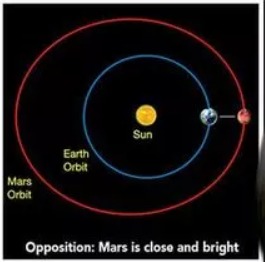In News
- Due to the ‘opposition’ effect, Mars will look much brighter and bigger than usual in October 2020.
What is the Opposition ?
- Opposition’ is the event when the sun, Earth and an outer planet (Mars in this case) are lined up, with the Earth in the middle. Which takes place every two years and two months, Mars will shine the brightest.
- The time of opposition is the point when the outer planet is typically also at its closest distance to the Earth for a given year, and because it is close, the planet appears brighter in the sky.
- An opposition can occur anywhere along Mars’ orbit, but when it happens when the planet is also closest to the sun, it is also particularly close to the Earth.
- It will outshine Jupiter, becoming the third brightest object (moon and Venus are first and second, respectively) in the night sky during the month of October.
Logic behind the name
- As per NASA, from an individual’s perspective on the Earth, Mars rises in the east and after staying up all night, it sets in the west just as the sun rises in the east and sets in the west.
- Because from the perspective on Earth, the sun and Mars appear to be on the opposite sides of the sky, Mars is said to be in “opposition”.
- Essentially, the opposition is a reference to “opposing the sun” in the sky

Mars Opposition: Mars and the Sun are on directly opposite sides of Earth.
- About every 26 months, the Earth passes between the Sun and Mars, this is when the three are arranged in a straight line.
- In 2020, while Mars’ closest approach to Earth was on 6th October, the opposition happened on 13th October.
- Mars’s next close approach will happen on 8th December, 2022, when the planet will be 62.07 km away from the Earth.
- Significantly, the closest distance is relative and hence can vary.
- As per NASA, Mars made its closest approach to Earth in 2003 in nearly 60,000 years and it won’t be that close to the planet until 2287.
- This is because the orbits of Earth and Mars are not perfectly circular and their shapes can change slightly because of gravitational tugging (pulling) by other planets. For instance, Jupiter influences the orbit of Mars.
















